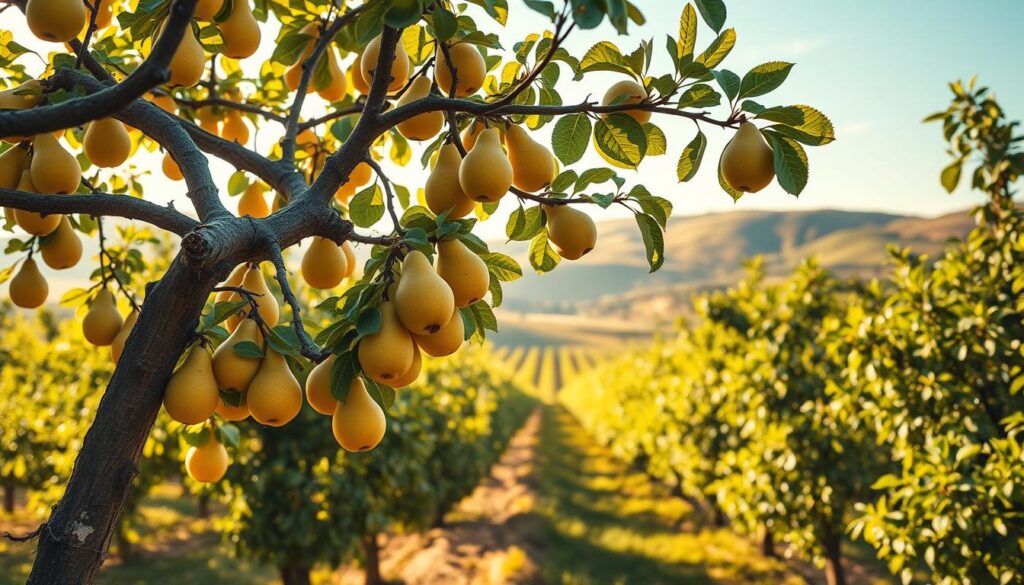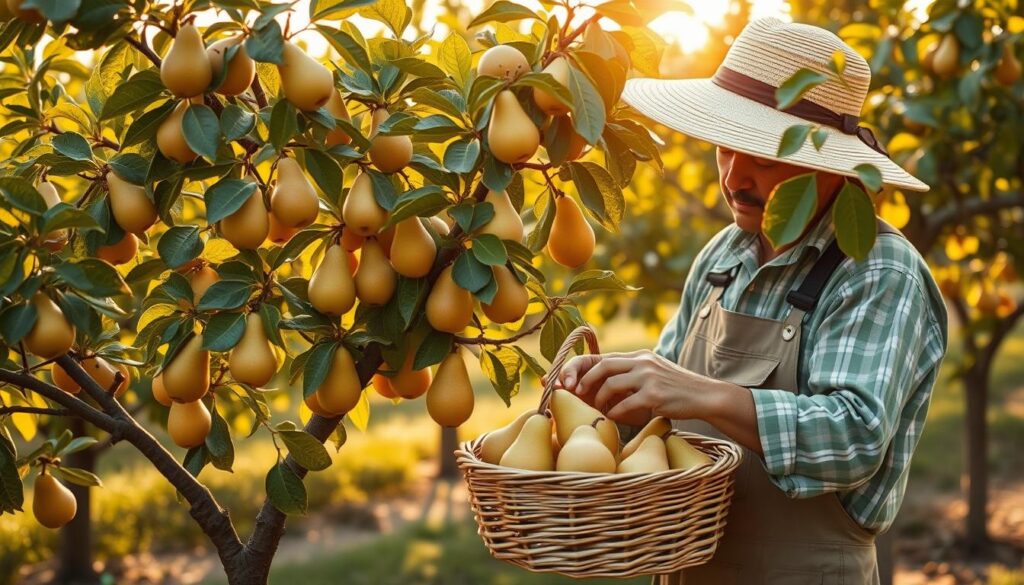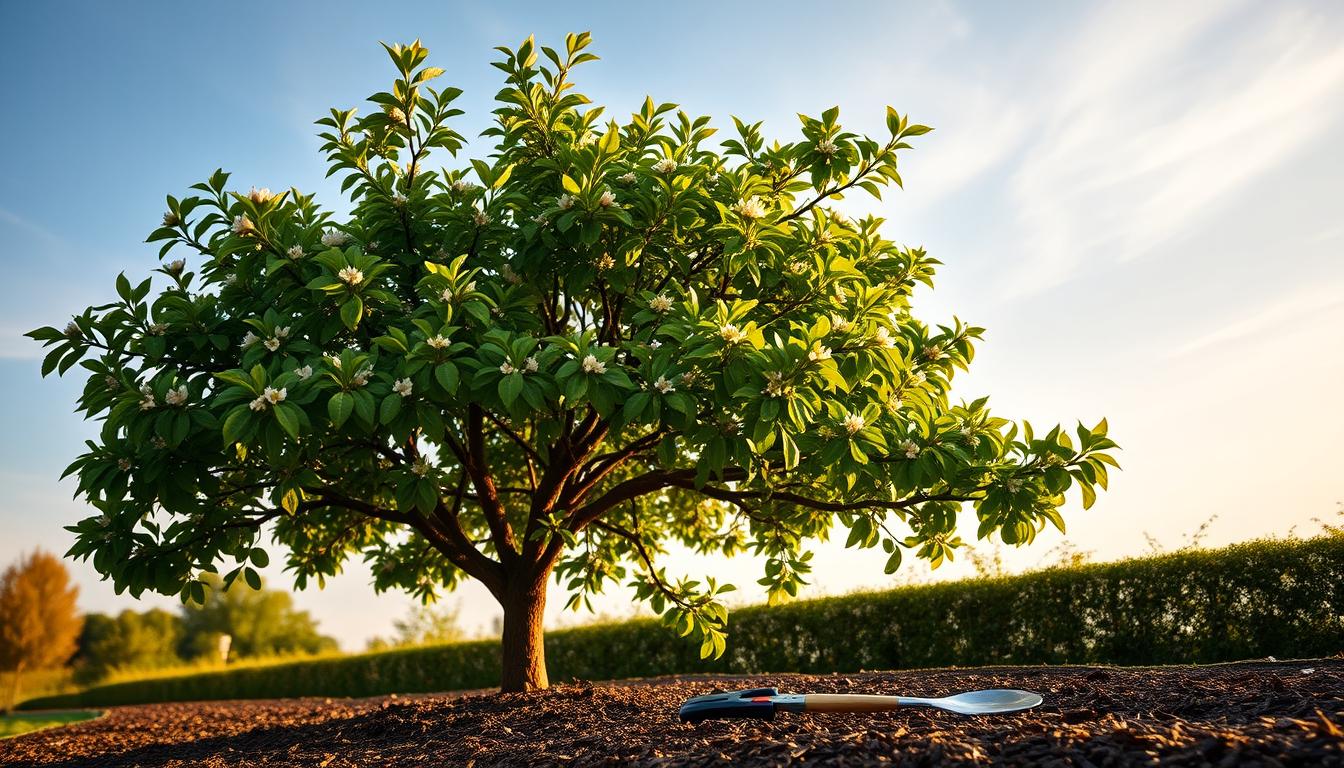Imagine walking into your backyard and picking a fresh, golden-bronze Asian pear from your tree. The Shingo pear tree makes growing your fruit a fun journey. It turns your garden into a fruitful orchard filled with sweet, juicy treats.
Shingo pear trees are a top choice for home gardeners. They offer delicious fruits and add beauty to your garden. Whether you’re new to gardening or love growing fruits, learning how to care for your Shingo pear tree is key. It leads to plenty of fruit and a beautiful garden.
This guide will teach you the best care tips for your pear tree. You’ll learn how to make it grow well, produce great fruits, and be the garden’s star.
Table of Contents
Understanding Asian Pear Varieties and Their Characteristics
Asian pears, known as Pyrus pyrifolia, are a unique part of fruit tree cultivation. They come from East Asia’s lush landscapes. This brings a rich heritage to today’s orchards.
Asian pears offer a wide range of cultivars with special traits. Their adaptability and flavors make them valuable in fruit tree cultivation.
Native Origins and Tree Description
Asian pears come from China, Japan, and Korea. They have unique features:
- Teardrop-shaped leaves with serrated edges
- White flower clusters blooming in early spring
- Compact tree structures adaptable to various climates
Popular Asian Pear Cultivars
| Cultivar | Origin | Unique Characteristics |
|---|---|---|
| Hosui | Japan | Sweet, russet-skinned fruit |
| Kosui | Japan | Early ripening with crisp texture |
| Nijisseiki | Japan | Large, round fruits with excellent storage life |
Distinguishing Features of Shingo Variety
The Shingo variety is special in Pyrus pyrifolia cultivation. It has round, golden-yellow fruits. They are crisp and sweet, unlike other Asian pears.
Knowing these differences helps gardeners and fruit lovers choose the right Asian pear. It depends on the growing conditions and what they like to eat.
Essential Growing Requirements for Your Shingo Pear Tree
To grow a healthy Shingo pear tree, you need to know its specific needs. These Asian pears need careful horticulture to grow well and give lots of fruit.
Getting enough sunlight is key for your Shingo pear tree. Growers say it needs six to eight hours of direct sunlight daily. This helps with blooming and fruit growth.
Key Growing Conditions
- Sunlight: 6-8 hours of direct sun exposure
- Soil pH: 6.0 to 6.5 (tolerates 5.0 to 7.5)
- Soil Type: Well-drained, loamy soil
- Hardiness Zones: USDA zones 5-9
The soil your Shingo pear tree grows in is also very important. It should be well-drained and loamy, with a pH that’s slightly acidic to neutral. This helps the roots grow strong and absorb nutrients well.
“Proper soil preparation is the foundation of successful fruit tree cultivation.” – Orchard Management Expert
Temperature and Chilling Requirements
Shingo pear trees need a certain amount of cold to wake up from their winter sleep. They need about 450 hours below 45°F (7°C) to grow well and produce fruit.
| Growing Requirement | Optimal Condition |
|---|---|
| Sunlight | 6-8 hours daily |
| Soil pH | 6.0-6.5 |
| Chilling Hours | 450 hours below 45°F |
| Hardiness Zones | 5-9 |
By focusing on these key growing needs, you’ll make a great place for your Shingo pear tree to grow. It will give you delicious fruit year after year.
Ideal Planting Conditions and Location Selection
Finding the perfect spot is key for healthy Shingo pear trees in your farm. The right place helps them grow strong and produce lots of fruit.
Before you start, think about these important things for your tree’s success:
- Evaluate your property’s microclimate
- Assess soil drainage capabilities
- Analyze sunlight exposure patterns
- Check wind protection areas
Soil Preparation Guidelines
Good farming starts with knowing your soil. Shingo pear trees do best in well-draining, slightly acidic soil. To prepare your spot, do the following:
- Conduct a comprehensive soil test
- Incorporate organic compost
- Ensure proper nutrient balance
- Improve soil structure with organic matter
Spacing and Sun Exposure Requirements
Make sure your Shingo pear trees have enough space. Plant them 15-20 feet apart for good air and no competition. Choose full sun spots for at least 6-8 hours of direct sunlight a day.
Best Planting Time and Techniques
Planting at the right time is crucial. Spring or fall, when it’s not too hot or cold, is best. Dig a hole that is twice as wide as the root ball and equal in depth. Handle the roots gently.
Watering and Fertilization Schedule

Managing an orchard well starts with knowing how to water and fertilize your Shingo pear trees. These trees need special care to stay healthy and produce lots of fruit.
Water is key for your Shingo pear tree’s life and fruit. Young trees need steady moisture, while older trees can handle a bit of dryness. Try to give them:
- 1-2 inches of water per week
- Deep, less frequent watering instead of shallow, more frequent
- Adjust watering based on your area’s weather and soil
Fertilizing is also important for your orchard. Use a balanced fertilizer in early spring when new growth starts. Nitrogen-rich fertilizers help trees grow strong, but don’t overdo it.
Choose a fertilizer with an NPK ratio of 10-10-10 or something similar. Here’s how to apply it:
- Spread it evenly around the tree’s drip line
- Make sure it’s at least 6 inches from the trunk
- Water thoroughly after applying to ensure the nutrients are absorbed into the soil.
Keep an eye on your Shingo pear tree’s soil moisture and nutrient levels. This will help your tree grow well and give you lots of fruit in your home orchard.
Pruning and Training Methods for Optimal Growth
Learning how to prune your Shingo pear tree is key to its health and fruit. Proper pruning shapes the tree and boosts fruit quality. It’s a vital part of horticulture.
Pruning needs vary with your tree’s growth stages. Each method has its purpose in keeping the tree healthy and productive.
Seasonal Pruning Guidelines
Prune majorly in winter, before spring growth. This timing reduces disease risk and aids in tree healing.
- Winter: Perform major structural pruning
- Summer: Remove water sprouts and damaged branches
- Growing season: Light maintenance pruning
Training Young Trees
Start with a young Shingo pear tree by setting a strong leader and scaffold branches. Cut back one-year whips to 36 inches. This encourages strong branch growth.
Maintenance Pruning for Mature Trees
For mature trees, prune to balance growth and fruit. Remove weak, shaded, or diseased branches. This keeps the tree healthy.
| Pruning Focus | Action | Benefit |
|---|---|---|
| Central Structure | Maintain central leader | Improves tree strength |
| Branch Angle | Select branches >45 degrees | Enhances structural integrity |
| Canopy Management | Thin interior branches | Increases sunlight penetration |
Pro tip: Always use clean, sharp pruning tools to prevent disease transmission and ensure clean cuts that heal quickly.
Cross-Pollination Requirements and Compatible Varieties
For Shinko pear trees to thrive, cross-pollination is key. Unlike some trees, Shinko pears need other trees to pollinate and grow well.
When setting up your fruit tree garden, pick pear varieties that bloom at the same time. Planting different varieties close together is crucial for good pollination.
Compatible Pollinator Varieties
- Chojuro
- Drippin’ Honey
- Olympic Giant
- Shinseiki
- 20th Century
These varieties bloom when Shinko pears do and are genetically compatible. Plant them 50-100 feet away from your main tree to boost pollination.
| Pollinator Variety | Bloom Timing | Compatibility Rating |
|---|---|---|
| Chojuro | Early Season | High |
| Shinseiki | Mid Season | Excellent |
| 20th Century | Late Season | Very Good |
Attracting pollinators is vital for your fruit tree’s success. Here are some tips:
- Introduce more bee colonies than typical fruit orchards
- Avoid pesticide use during bloom periods
- Create bee-friendly garden environments
Tip: Timing is everything in cross-pollination. Introduce bees when trees are one-third in bloom for optimal results.
Common Pests and Disease Management
Keeping your Shingo pear tree safe from pests and diseases is key to a healthy orchard. Organic pest control methods can protect your tree without using harsh chemicals.
Identifying Major Pest Issues
Shingo pear trees face threats from many insects. These pests can harm the tree and reduce fruit production. Watch out for:
- Codling moths
- Pear psylla
- Aphids
- Spider mites
Disease Prevention Strategies
Understanding common diseases is the first step in prevention. Fire blight is a big worry for Asian pear trees. Here are some steps to take:
- Maintain proper tree spacing
- Ensure good air circulation
- Practice regular pruning
- Remove infected branches immediately
Organic Control Methods
Organic pest control needs a mix of strategies. Here’s a plan to keep your Shingo pear tree safe:
| Pest/Disease | Organic Control Method | Frequency |
|---|---|---|
| Aphids | Neem oil spray | Every 7-10 days |
| Codling Moths | Pheromone traps | Throughout growing season |
| Fire Blight | Copper-based fungicides | Early spring |
Using these organic pest control methods will keep your Shingo pear tree safe. It also helps you manage your orchard in an eco-friendly way.
Harvesting and Storage Techniques

Mastering fruit tree cultivation means knowing how to harvest your Shingo pears correctly. These Asian pears need extra care to get the best taste and quality.
Figuring out when to pick them is key. Look for these signs:
- Watch for skin color changing from green to yellowish-green or golden brown
- Check stem attachment – fruit should detach easily when gently twisted
- Avoid pulling fruits that resist picking, as they are not yet ripe
When you pick them, handle them gently. This keeps the skin from getting bruised. It also helps keep the fruit fresh longer.
Storing your harvest is also important. Here’s how to do it right:
- Store at precisely 0°C (32°F)
- Maintain 90-95% relative humidity
- Expect storage duration of several months
Shingo pears stay firm even after they’re picked. You can eat them right away or store them for months without losing their quality.
Pro tip: Always handle your Shingo pears with care to preserve their delicate nature and exceptional taste.
Propagation Methods and Success Tips
Grafting is the main way to grow Shingo pear trees with the same traits. It’s different from growing from seeds. Grafting makes sure you get a tree that’s just like the parent tree, keeping its special qualities and fruit.
To succeed in grafting, you need to pick the right techniques. The top methods for growing Asian pears include:
- Whip grafting
- Cleft grafting
- Budding techniques
Success in grafting depends on a few key things:
- Choose healthy rootstock from compatible pear varieties
- Select disease-free scion wood
- Perform grafting during dormant winter months
- Maintain precise cutting and alignment techniques
Pro tip: Always use sterilized grafting tools to prevent potential disease transmission between trees.
“Grafting is an art that combines scientific precision with horticultural skill” – Orchard Experts
While grafting is the best way to grow trees, some try planting seeds. But seeds don’t usually grow trees that look like the parent. So, grafting is the best choice for trees that have the same Shingo pear tree traits.
Seasonal Care Guide for Shingo Pear Trees
Managing Shingo pear trees well needs a careful plan for each season. With the right care, your trees will grow strong and produce lots of fruit. This approach also helps the environment.
Knowing what your Shingo pear trees need in each season is key. Each time of year has its tasks to keep the trees healthy and fruitful.
Spring Care Routine
Spring is a big time for your Shingo pear tree’s growth. Here are the important steps:
- Deep watering at planting time
- Apply all-purpose fruit tree fertilizer
- Prune before new growth emerges
- Remove dead or damaged branches
- Thin young fruit when they reach dime-size
Summer Maintenance Tasks
In summer, your focus shifts to keeping the trees healthy and the fruit growing:
- Monitor soil moisture carefully
- Water when surface becomes dry
- Continue fruit thinning
- Watch for pest activity
- Ensure adequate sunlight exposure
Fall and Winter Protection
Get your Shingo pear trees ready for sleep with these steps:
- Clean up fallen leaves and debris
- Protect roots from frost
- Reduce watering frequency
- Inspect for winter damage
- Plan next season’s pruning
Regular care keeps your Shingo pear trees healthy, productive, and ready to give you great fruit every year.
Conclusion
Growing a successful Shingo pear tree needs dedication and knowledge of its unique traits. By following the six key care strategies in this guide, you can make your garden better. You’ll have a tree that’s not just beautiful but also gives delicious fruits.
Your shingo pear tree’s health relies on your consistent care. You must pick the right spot, manage pruning, fertilize, and control pests. Each step is important for a strong and fruitful tree. Your hard work will pay off with plenty of golden-bronze fruits.
Working with the shingo pear tree is more than growing a fruit tree. It’s about connecting with a long agricultural tradition. By using the detailed methods in this guide, you’ll not only grow a remarkable tree. You’ll also learn valuable skills for managing fruit trees in your garden.
Be patient and enjoy watching your shingo pear tree grow. With the right care, you’ll soon pick your own Asian pears from your backyard.
FAQ
How long does it take for a Shingo pear tree to produce fruit?
A Shingo pear tree starts producing fruit 3-5 years after planting. This depends on the tree’s age and the growing conditions. Young trees grafted from another tree tend to fruit sooner than those grown from seed.
Are Shingo pear trees self-pollinating?
No, Shingo pear trees need cross-pollination to produce fruit. You should plant at least two different Asian pear varieties close together. This ensures good pollination and fruit set.
What is the ideal soil pH for growing Shingo pear trees?
Shingo pear trees do best in slightly acidic to neutral soil. The pH should be between 6.0 and 7.0. Test your soil and adjust it if needed for the best tree growth.
How often should I water my mature Shingo pear tree?
Water your mature Shingo pear tree deeply once a week during the growing season. Give it about 1-2 inches of water. Adjust this based on rainfall, temperature, and soil moisture. Avoid overwatering to prevent root rot.
What are the most common pests that affect Shingo pear trees?
Common pests include pear psylla, codling moths, aphids, and spider mites. Regular monitoring and proper pruning can help manage these pests. Keeping the tree healthy is also key.
When is the best time to prune a Shingo pear tree?
The best time to prune Shingo pear trees is in late winter or early spring. Prune just before new growth starts. This minimizes stress and reduces disease risk.
Can I grow a Shingo pear tree in a container?
Yes, but it’s challenging. Choose a dwarf variety and use a large container with good drainage. Provide extra care, including regular fertilization and winter protection.
How do I know when Shingo pears are ready to harvest?
Shingo pears are ready when they’re fully colored and slightly soft. They should come off the tree easily with a twist. They typically ripen from late summer to early fall.
What are the best companion plants for Shingo pear trees?
Good companion plants include clover, lavender, marigolds, and other flowering plants. They attract pollinators. Avoid trees that compete for nutrients or may have similar pests.
How long do Shingo pear trees typically live?
With proper care, a Shingo pear tree can live 25-50 years. Factors like growing conditions, pest management, and regular pruning affect its longevity and productivity.

